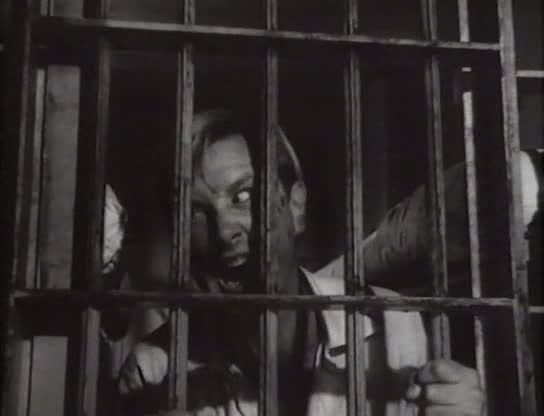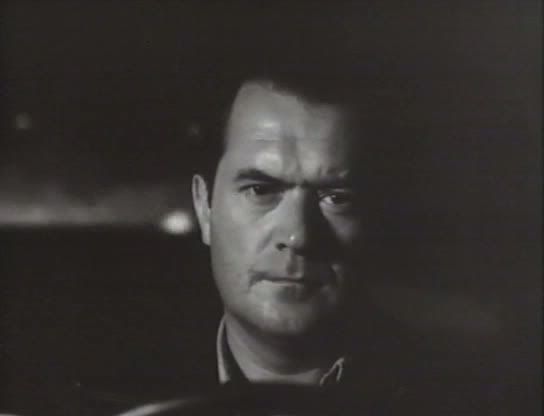
[This is a contribution to For the Love of Film (Noir), the second Film Preservation Blogathon hosted by Ferdy on Films and Self-Styled Siren. The blogathon has been organized for the benefit of the Film Noir Foundation, who do important work to restore and preserve the noir heritage. Please consider donating to the Foundation during this week. The blogathon will run from February 14-21, and during this time I'll be posting about some noirs to raise awareness of the blogathon and its worthy cause. The film I'm writing about today is the actual film that is going to be preserved and restored due in part to the efforts of this blogathon; every dollar contributed through the blogathon donation link will go to restoring this film.]
Cy Endfield's The Sound of Fury is based on the same true story as the Fritz Lang-directed Fury from fourteen years earlier, and both films are concerned with the mob mentality of lynchings and revenge. The films approach this story from very different angles, though, and they wind up being completely different films with somewhat overlapping themes. In Endfield's film, Howard Tyler (Frank Lovejoy) is a struggling family man with a pregnant wife (Kathleen Ryan) and a young son. Tyler is determined to find a job, but in a depressed economy he's not having much luck, and all his prospects come to nothing. When he returns to his home after a failed job-hunting trip, it's heartbreaking to see the hope and joy in his wife's face when she momentarily thinks that he's found something, as though she's been restraining her worries for so long that they finally burst out in a brief burst of hope. As in Lang's film, economic pressure is at the forefront here, straining what would otherwise doubtless be a good relationship, but unlike in Fury, Tyler is not an innocent man. Tyler cannot resist the temptations of crime, not when he can't find any other job, not when his wife breaks down crying at their kitchen table because they don't even have the money to buy groceries and they're quickly running out of credit. So when Tyler meets the smooth-talking Jerry Slocum (Lloyd Bridges), initially thinking that he's being an offered a straight job at last, he decides to become Slocum's accomplice on a series of gas station holdups.
This is an archetypal noir scenario, the basically decent man who's corrupted by his circumstances. What's interesting about The Sound of Fury is the sympathy that's developed for Tyler, even as he willfully abandons his decent suburban life in favor of an escalating crime spree. He increasingly exists only at night, leaving behind his home and the daytime, spending his nights behind the wheel of a getaway car, watching Slocum rob gas stations and return to the car with fistfuls of bills. Endfield captures this ordinary guy's moral degradation with a direct, emotional style, contrasting Tyler's guilty conscience and hesitation against the smirking, sinister Slocum. Bridges seethes with intensity here, initially coming across as simply a cheery huckster — and something of a dandy, admiring his muscles in a mirror as he smears on cologne and puts on his silk shirts — who eventually reveals much darker undercurrents. The first scenes between Slocum and Tyler are staged like a seduction, as Slocum takes Tyler back to his apartment, where he shows off his wealth and his muscular torso. It almost seems like a gay come-on, but really what Slocum wants is to lure his prey into being his accomplise.
The darkness lurking beneath this dandy persona comes to the fore when Slocum hatches a plot to bring the duo's criminal partnership to the next level by kidnapping a rich man's son and holding him for ransom. The kidnapping is one of the film's best sequences, a tense and shadowy nighttime set piece as Slocum and Tyler kidnap the rich young man and try to stow him at an abandoned military base while awaiting the ransom's delivery. Of course, the plan goes wrong almost instantly, and Slocum reacts with a horrifying act of violence, fully revealing the raving evil that had been lurking just beneath the surface of his slick gangster image. Tyler tries to stop his partner, but when he fails Endfield frames Tyler in the foreground, his head in his hands, sobbing in despair and weakness, as in the background Slocum pounds a rock, brutally and repeatedly, onto the head of their victim.

The film also deals, like Lang's, with mob violence and the threat of lynchings. Throughout the film, Endfield occasionally intersperses Tyler's story with scenes involving the reporter Gil Stanton (Richard Carlson), a yellow journalist who believes that he's performing a valuable public service by stirring up public sentiment and appealing to the public's most virulent emotions. Stanton's editor convinces him to drum up circulation by exaggerating Slocum's scattered gas station robberies into a massive crime wave perpetrated by a vicious criminal gang. This is only the start of the newspaper's complicity in creating a public atmosphere conducive to punishing the criminals in the most violent possible way. As in Fury, these scenes are extremely didactic, hammering home the point that the justice system shouldn't be subverted, that innocence is presumed until a fair trial proves guilt, that journalistic sensationalism inflames ugly emotions by appealing to the worst in people. Stanton's friend (Renzo Cesana) provides the moralistic voice delivering these sentiments, lecturing his friend — and the audience — about the importance of fair trials and the dangers of the media's influence. Such concerns seem almost quaint now, in an era of widespread media saturation and sensationalistic coverage of everything and anything, but this film presents exaggerated newspaper headlines as though they're capable of tearing apart the fabric of the world.
As a result, the film's climax takes on a hysterical tone as the jail where Tyler and Slocum are being held is surrounded by a massive angry mob, eager to pull the two criminals outside and enact mob justice without waiting for the courts. The soundtrack becomes shrill and deafening, dominated by the crowd's screams and the frazzled rants of Slocum as he rattles around in his small jail cell. The contrast between the resignation of Tyler — who knows that he's done wrong and feels crippling guilt as a result — and the caged-animal rage of Slocum creates a compelling tension in the scene, even beyond the slow-building tension of the mob gathered outside. The roar of the crowd, the constant noise clattering on the soundtrack, abruptly cuts off for the quiet finale as, nearby, the sheriff and the newspaper reporters wait helplessly as the crowd drags Slocum and Tyler away to be killed. The eerie silence of the scene is shattered twice, with a distant cheer like at a sporting event, one cheer for each man who's dying. It's a chilling scene, with the seeming joy of the crowd contrasting awfully against the horror of what they're celebrating.
Also very compelling are the earlier scenes in which Tyler and Slocum, before they're caught, go out with two girls, Hazel and Velma (Katherine Locke and Adele Jergens), as cover for their mission to mail the ransom note in a neighboring town. The justification for this outing is narratively flimsy, but what's fascinating about it is how Endfield briefly pulls the focus off of the main story to focus on these two girls, who know nothing about the kidnapping plot and simply think they're going out on a fun date. Velma is Slocum's long-time girl, a statuesque good-time girl whose relationship with this unpredictable sociopath is as volatile as expected, alternating between steamy passion and bouts of anger and mutual violence. Hazel is very different, a shy and lonely woman who says she's saving herself for marriage, and who immediately clings to Tyler despite his brooding manner. The scene where the two women prep for their date, chatting and exchanging their hopes and dreams about the happiness and glamour they'd like to experience, is an interesting moment precisely because it's so peripheral to everything else that happens, an acknowledgment that these characters, who would be mere plot devices in any other movie, have lives and dreams of their own. (Interestingly, the two girls are much more thoroughly developed than Tyler's weepy, melodramatic wife, an utterly boring personality vacuum.)
In the end, The Sound of Fury is a fine noir that chronicles the descent of a normal guy into crime, driven there by economic desperation, and though the film is unflinching in examining the consequences of Tyler's weakness, it's also a bold plea on behalf of justice and order, a rejection of the bloodthirsty drive for revenge. Endfield's film is very much deserving of the restoration effort being conducted by this blogathon and by the Film Noir Foundation. As one can no doubt see from the screen captures included with this post, the film, with its heavy blacks and dark atmosphere, is definitely in need of a restoration so that one could descend, with Tyler, more completely into the inky blackness of his sad fate.







0Awesome Comments!